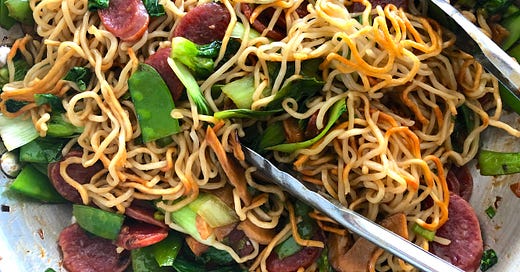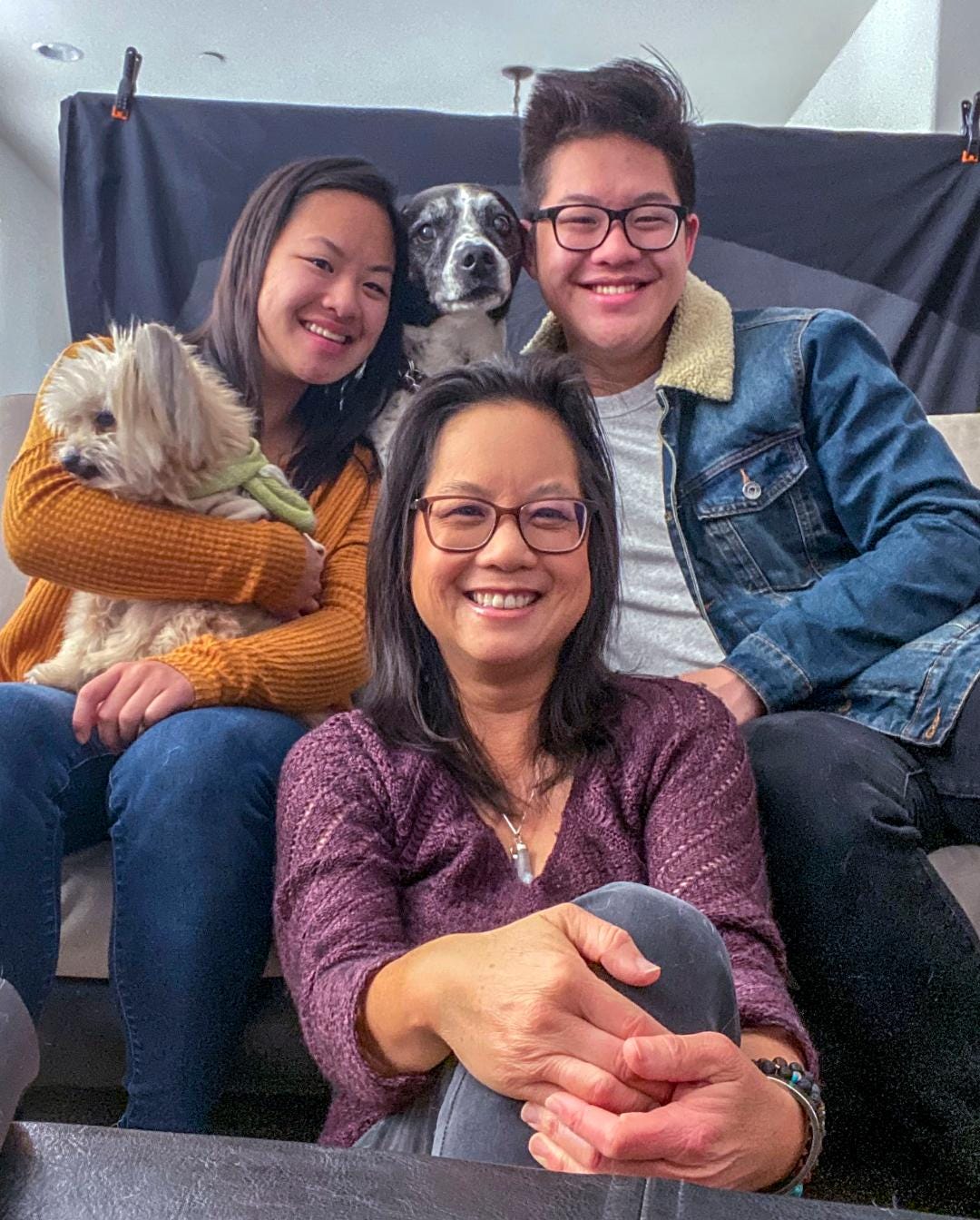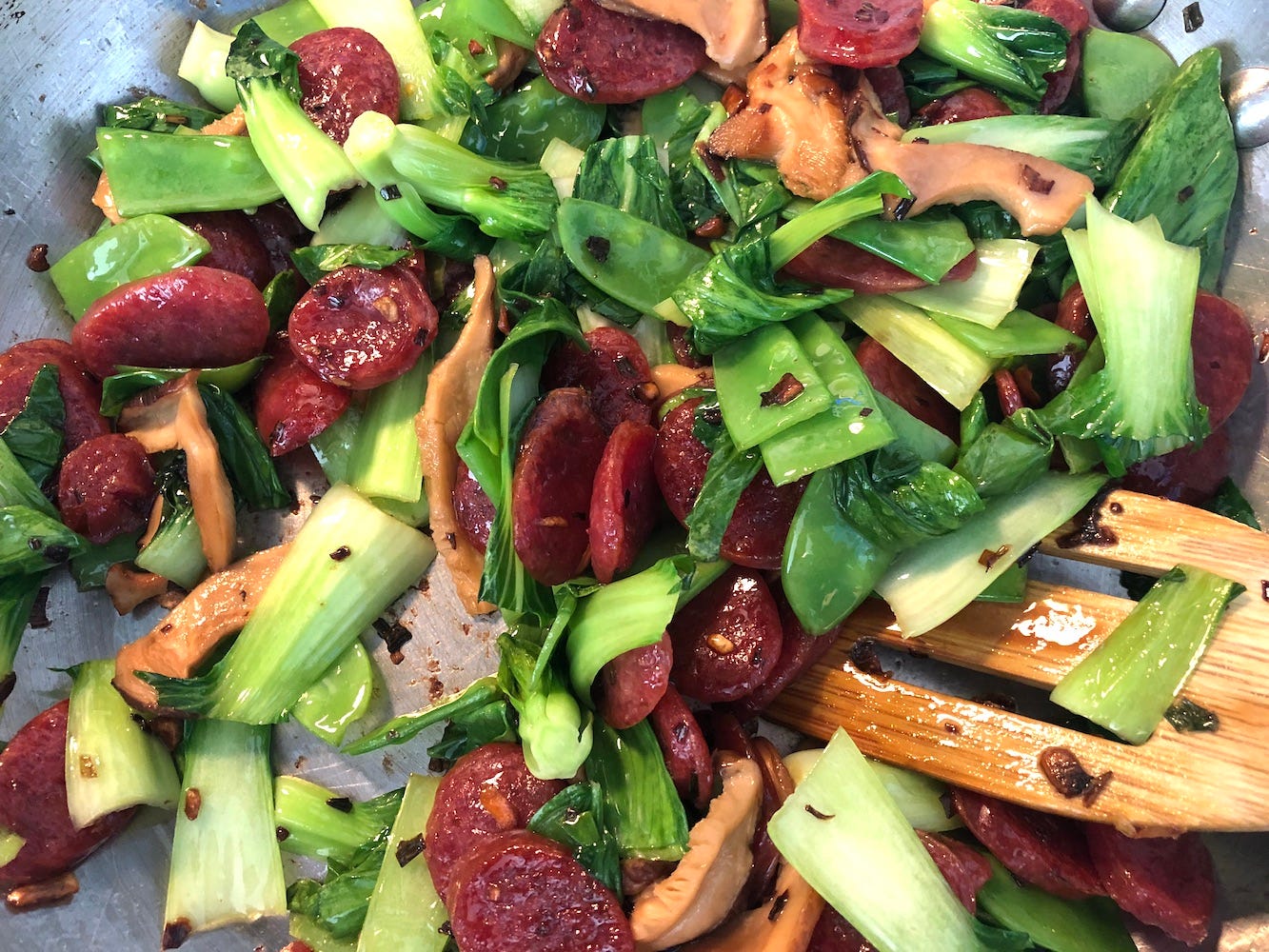This week I’m sharing a classic Chinese American recipe, courtesy of Denise Lee, an educator who uses Legos to teach kids STEM subjects like robotics. Denise’s cousin Lorraine Hee-Chorley was the subject of my very first newsletter, and she shared the story of their great-grandfather’s journey to California during the Gold Rush. Denise told me a bit about her father’s childhood in San Francisco’s Chinatown and shared a recipe for Chow Mein that she recreated by drawing on her memories of her father’s cooking and consulting a variety of sources.
Because I already knew much of Denise’s family history when we spoke, we kept our conversation focused on more recent stories and on the cooking, so this is primarily a recipe post with a little bit of an intro. If you haven’t read the family’s history yet, make sure to check it out here:
Denise Lee
My dad’s dad was born in San Francisco, and then the rest of us kind of took off from there. On my mother’s side of the family, I don’t know as much about their history. I wish my maternal grandfather had talked about it, but he would not. He was actually interned in Angel Island. Trying to talk about our folklore and our true history is difficult, because a lot of old people don’t want to talk about it. There are certain things that we know in our family history through hearsay, but we can’t prove it, because we don’t talk.
I always remember the Cantonese food as something that we gathered together to make and eat. Growing up, the younger kids—us—we’d be setting up the table, passing around the bowls. The older people, they’d be cooking and chopping.
My dad was born in 1928. In the 1930s, his family lived over Eastern Bakery, in San Francisco. There was his mom and dad, and then seven kids. So, there was nine of them altogether. Besides them, on that floor, there was his friend Chu and his family. And then on another side, there was a bachelor. And on that floor, there was just one bathroom. They had running water, but it wasn’t hot water.
My dad remembers making dumplings. My dad remembers making the dough too with his mom. And he says, “I don’t know if I did a good job, but it’s just something you did with your parents and your grandparents.”
I remember folding wontons. I remember it’s bloody early in the morning, and we’re all around the table. It would be my mom and the older women, and they’re be making the pork mixture that goes into the middle of the wontons. Then everybody sits at the table, and they get the little square wonton wrappers, and we start wrapping wontons. We all do this, and we load it up on a sheet pan, and we’d throw them in the freezer for a while. Then we’d bag them up. That would be like on Sunday morning, because then you have it all ready for the rest of the week. Then you’d have all these meals this way, because all you’d do later is make some soup. It’s hot, you’ve got your protein in there, you’ve got bamboo shoots or some green onions—whatever they want to put in there. And when you make the soup, you throw in some baby bok choy, and you’d do some garnish and maybe some cilantro and some green onions. And that would be your meal.
I still used to do the wontons when I had more time. One of the things I like to make is particularly for Chinese New Year, but I just make it because I liked it; it’s more of a wonton dish with sugar. We called it “peanut gok.” Instead of a square wonton wrapper, I use a round one, and fill it with crushed up peanuts and some brown sugar, and then deep fry it.
When we were little, we really bemoaned the fact that we had to wake up early in the morning and help out. So we didn’t really pay attention. We’d just find ways, excuses, to not help, and so we don’t remember how to do it. My dad doesn’t remember either, he’s 92. So I found a great book that I cherish, the Chinese Village Cookbook. That has all of our cooking. So I just kind of look at the basic recipe, and then decide what to add in.
Recipe: Chow Mein
In some ways, this is a very classic recipe for chow mein, and in some ways it’s a very California dish. Denise tends to change the ingredients, depending on what she has on hand, and instead of pan-frying the noodles, she bakes them with oil, a trick she picked up from Chinese Village Cooking by Rhoda Yee when she was first trying to recreate her father’s recipe. She also cooks the sausage and vegetable topping in a high-sided pan, instead of a wok, because that’s what she has in her kitchen.
A word about some of the Chinese ingredients: All of the ingredients here are readily available at East Asian markets (and at many other supermarkets). If you’re not familiar with lap cheong, it’s a firm Chinese sausage with a very sweet taste (which contrasts nicely with the mustardy flavor of the bok choy). They’re about the size and shape of hot dogs and, like hot dogs, come in plastic packages. To rehydrate the shitake slices, soak them in cool water for a couple of hours. Never rehydrate in hot water, as it will rob the mushrooms of their flavor. Drain the mushrooms and squeeze out excess moisture before using. (A large handful of slices should give you about ½ cup once hydrated.) Lastly, the bok choy used in this recipe are about 3” long. Chinese greens are often labeled erroneously in many markets. These may be called baby bok choy or Shanghai bok choy in some places.
Prep Time: 25 minutes (plus 2 hours if soaking mushrooms)
Cook Time: 30 to 40 minutes
1 16-oz package Chinese egg noodles
1 tablespoon Canola oil
1 tablespoon olive oil
1 tablespoon roughly chopped garlic
1 scallion, thinly sliced crosswise and then roughly chopped, plus 2 scallions, thinly sliced
2 cups sliced lap cheong sausage (about ½ lb)
½ cup chicken stock, plus more if needed
1 heaping tablespoon hoisin sauce
1 tablespoon light soy sauce
1 teaspoon toasted sesame oil
1 teaspoon finely grated ginger
1 teaspoons cornstarch
1 cup rehydrated shiitake slices (optional)
1 cup snow peas, cut in half crosswise
10 small bok choy (3” to 4” long), stem ends removed, cut crosswise into 1” to 1 ½” pieces
1. Bring a large pot of water to a boil. Boil the noodles for 3 minutes, then drain them and rinse them with cold water (to keep them from sticking). Drain well.
2. Preheat the oven to 400°. Pour the canola oil onto a baking pan, and tip the pan from side to side to spread the oil. Put the noodles on the pan and spread them out into a thin layer. Bake the noodles until brown and crispy, about 20 minutes (see tester’s note, below).
3. While the noodles are baking, heat a high-sided pan (or a wok) over low heat. Add the olive oil, and let it heat for a minute. Add the garlic and the chopped scallion, and stir, then add the sausage to the pan. Turn the heat up to medium-high, and cook, stirring occasionally, until the meat starts to crisp and the onions frizzle, about 3 minutes.
4. While the sausage is cooking, prep the sauce: Combine the chicken stock, hoisin, soy sauce, sesame oil, ginger, and cornstarch, in a small bowl and mix well.
5. When the sausage has cooked, add the shiitake, snow peas, and bok choy to the pan. Cook, stirring, until the vegetables are partially cooked but still crisp, about 3 minutes.
6. Add the sauce to the pan (stirring the ingredients well just before pouring them in), and mix. Add the remaining sliced scallions. (Remove the pan from the heat if the noodles are not yet ready, then reheat before adding the noodles.)
7. When the noodles are cooked, remove them from the oven, and slide them into the pan with the other ingredients. Mix everything well; if the noodles look dry, add more of the chicken broth. Serve immediately.
Tester’s Note:
Not all Chinese noodle brands are the same, and not all ovens have the same heat distribution. If your noodles are not crisp after 20 minutes, check the bottoms, where they touch the pan—they’re likely crisp on that side. You can flip the noodles and bake them a bit longer, to crisp the other side (another Rhoda Yee trick), or stick them in the broiler and crisp the tops, being careful not to burn them.
More California Recipes
Looking for more things to cook this week? The LA Times has a fantastic package of recipes honoring the country’s earliest Black chefs for the Fourth of July and a collection of grilled vegetable recipes. If you’re looking to stay cool in the kitchen, the blog Craving California has a lovely recipe for hamachi crudo with grapefruit and serrano chile, and Edible Sacramento has a bunch of cocktail recipes that use fresh herbs from the garden.
Photos: Georgia Freedman, Courtesy Denise Lee (2), Georgia Freedman








